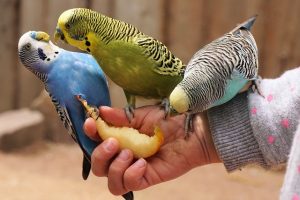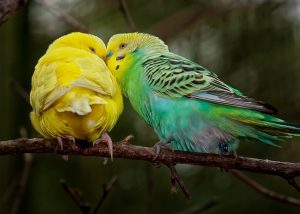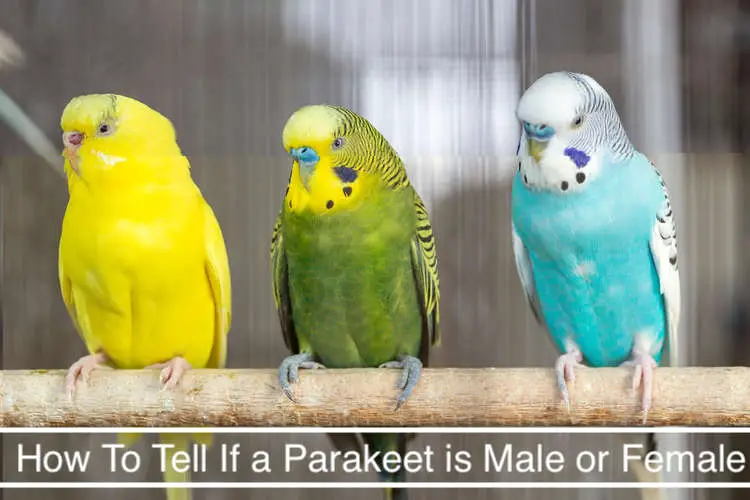However, a lot of people often get curious to know the gender of their parakeet, especially when naming the parakeet. Imagine a male parakeet, different by a solid lavender to the deep blue cere – the area of skin encircling their nostrils. In contrast, a female cere that ranges from white to varying shades of brown is a transformation influenced by factors like hormones and age.
As we delve into this exploration, we’ll uncover how this seemingly minor detail plays a significant role in distinguishing male from female parakeets.
How Many Ways are There to Differentiate Between Male vs Female Parakeets

There are a lot of ways to differentiate between a male and a female parakeet, with some being more precise than others.
In some cases, the methods to differentiate them may be complicated, especially when the parakeets are ambiguously pigmented or non-pigmented, including diluted color, recessive-pied variants, lutinos, or albinos.
Generally, the three common ways of differentiating between male and female parakeets are checking their color pattern, performing DNA testing on the parakeets, and observing their behavior.
It’s worth noting that these methods may involve looking for a few distinctive features, like checking for spots, baby tints, and ceres.
In some technical cases, people often resort to more complex ways to identify whether their parakeet is male or female.
It may involve getting blood samples from their pet parakeet and taking it to a specialist for different identification tests.
| Image | Brand | Price |
|---|---|---|
 | Yaheetech | |
 | Prevue Hendryx | |
 | Vision | |
 | Kaytee | |
 | Kaytee | |
 | Super Bird Creations | |
 | Lixit | |
 | Super Bird Creations | |
 | Wild Harvest |
7 Identification Process – How To Tell If a Parakeet is Male or Female
Color is one of the most reliable indicators of whether a parakeet is male or female. However, for this to be accurate, the birds must be matured to a certain level.
Using the color pattern to identify the gender of your parakeet will only work if they are at least 8 to 12 months. This is when their gender colors start to appear.
When checking the color pattern of your parakeet, there are certain body parts you’ll need to focus on, and they include the following:
If you are looking for a big cage for your Budgies then this guide is for you.
01. Ceres
Checking the cere’s color is an easy way to tell whether the parakeet is male or female. The cere is the raised fleshy skin that is located above the nostril.
A male parakeet may either be purplish-blue, blue, or pink, whereas a female parakeet, the color may be shades of brown, or white.
The colors are very distinctive, so it’s a reliable visual. Female parakeets are generally likely to have lighter ceres, while males tend to have darker ceres.
Male parakeets with light colors like lutinos and albinos may retain the color of their ceres even after maturity.
The ceres of a female ready to mate usually change to dark brown, with a flaky texture.
02. Leg/Feet
The color of the feet is also a way to tell whether your parakeet is a female or male.
As the parakeet matures, their sex hormones affect different parts of their body, including the skin of their legs and feet.
The feet of old parakeets older than 12 months are bright blue color while that of the female is brown or pink.
Like with ceres, you’ll also need to wait until the parakeet matures before you check the color of their feet.
03. Baby Tints
This is another indicator that you can use to check the gender of your parakeet.
Baby tints usually appear when the parakeet is less than a month old, and it’s a ring usually around their nostrils.
The tint is white around the nostrils of the female parakeet and purple or pink on the male parakeet.
04. Cheek Spots
Although it may not be the most accurate way to check the gender of your parakeet, cheek spots may be helpful in many cases.
Check their cheeks for visible spots. Female parakeets have light purple freckles, while male parakeets have dark purple spots.
05. Exceptions To Color Rule of Ceres For Different Breeds of Parakeet

Even though the color of the ceres is an effective way to tell the gender of your parakeet, there are a few exceptions to the rule.
For example, when the hormone level of a female parakeet is low, or when the parakeet is ill, the cere may have a light blue color. The color for a male parakeet may be brownish-pink or brown.
Another exception is with a newborn parakeet, as their ceres are pink and only start to change color after a few weeks. Other exceptions include:
- Cinnamon parakeets, as both sexes have pink ceres.
- Parakeets that are bred especially tend to have different colors, and they cannot be distinguished simply from their ceres.
- Coloring doesn’t apply to albino parakeets, and their feet, legs, and ceres are pink.
It’s not always easy to tell the gender of a parakeet when they are still young, but you can do this when they are sexually mature if the parakeet is rather crusty or starts to swell during mating season.
If it doesn’t happen this way, it means it’s likely a male parakeet.
On some specially bred parakeets, their ceres are usually mottled at a young age, but when they attain a certain level of maturity, or after a year, they start to have easily distinguishable color.
06. By DNA Testing: How To Tell If a Parakeet is a Male or Female
There are a lot of indicators that people use to identify the gender of their parakeet. However, DNA testing remains the only testing that’s 100% accurate.
You’ll need to take a feather and blood sample to your veterinarian or to a laboratory for gender testing to be done.
Even though it’s an expensive way to determine the gender of your parakeet, it gives 100% accurate results.
Also, people who don’t want to go through checking body parts of color patterns will prefer this option.
As mentioned earlier, your vet will need blood or feather samples of your parakeet to perform the test.
In some cases, the vet may only use feathers for the test as getting blood samples can be traumatizing to the parakeet, but it’s easy to pluck out the feathers and use them for the test.
Whether it’s the feather that’s used or blood samples, the results in both cases are 100% accurate.
One interesting thing about DNA testing is that for baby parakeets, especially those that recently hatched, you won’t need to use their blood or feather for the test.
You can use the eggshells they broke from for DNA testing. This is because the shells also hold DNA samples of the bird that hatched from it and using them is less invasive.
However, if you decide to use the eggshells for DNA testing, then you’ll need to ensure that it’s done within a few hours after hatching.
The eggshell may not retain the DNA sample of the bird if it is left for days before the testing is done.
07. By Observing Their Behavior: How To Tell The Gender of a Parakeet
Behaviors are another indicator to use to tell the sex of your parakeet.
Parakeets communicate with humans and other birds in many ways, and their body languages are easy to read.
If you properly read their behavior, you can easily place your parakeet in the gender chart.
A male parakeet has the tendency to tab his beak on the cage or bob his head repeatedly, and they tend to have an outgoing and playful appearance.
On the other hand, the female parakeet is rather aggressive, especially when in a mating mood, fertile, or subdued.
In some cases, you might notice the male regurgitating their food towards the female, but it’s nothing to worry about, as it’s expected behavior before mating.
Also, the male parakeets sing before mating, while the female parakeet makes loud noises act bossy and flustered. However, you’ll never hear the female parakeet singing before mating.
Even though behavior can tell you whether the parakeet is male or female, you need to note that it cannot always be said that males or females have one way of behaving.
The few behaviors above are only general, and there may be a few distinctions in some instances.
Male Female Parakeet Gender Chart

There are a lot of traits that can make it easier for you to place your parakeet in the correct position on the parakeet gender chart.
Here are some of the behavioral indicators that can help you do this correctly:
- The male parakeet is generally calmer, unlike the female ones that are rather aggressive
- When in a cage, you’ll notice the male parakeet bobbing their hands against the cage, and this is because they are more social than the female parakeet.
- Female parakeets do not sing, but they always make loud noises.
The best way to go about identifying the gender of your parakeet is by combining different indicators together.
Even though the DNA testing method remains the most accurate, not everyone can afford a DNA test done.
Therefore, in such a situation, the behavioral traits of the parakeet, alongside other indicators like color, will help you place them accurately in the male-female parakeet gender chart.
Female vs Male Parakeet: How Accurate Are These Identification Process?
You might already be thinking about the level of accuracy of these identification processes and if they will help you tell whether you have a male or a female parakeet.
Among all the methods we have mentioned above, DNA testing remains the most accurate, and it is without any exception.
Whether it’s from a feather sample or blood sample, a DNA test to identify the gender of a parakeet will always give accurate results.
If the test is performed on a mature bird that meets all criteria and you’re sure that there are no exceptions, then you can expect the identification process to be accurate.
However, when checking color patterns, it may not be as precise as you would expect it to be, and there are also exceptions, like if the parakeet is an albino or lutino.
Also, if the bird is still young, you may not be able to identify the gender from its color pattern.
General FAQs
Here are answers to some frequently asked questions about how to tell the gender of a parakeet:
How to tell the difference between a male and female parakeet?
To different between a male and female parakeet, look for cues like cere colour (the skin above the beak), size, vocalizations, nesting behaviour, and territorial actions. Consulting an expert or DNA testing can also provide a definitive answer.
What is The Less Stressful and Safest Way To Check The Identity of Your Parakeet?
You can check your parakeet’s identity in different ways. Some of the common methods include endoscopic sexing, blood sexing, visual sexing (identifying color pattern and behavior), and feather sexing.
However, eggshell sexing is the safest way to check the gender of your parakeet.
This is because it’s a non-invasive method, and you only need to take the eggshell for testing after hatching. In addition, eggshell sexing also gives accurate results that you can rely on.
Why is Endoscopy Not So Common?
Even though it is one of the easiest and fastest ways to check the gender of your parakeet, it has a couple of disadvantages which is why it is not as popular as the other methods we have mentioned above.
Unlike the other identification process, endoscopy is an expensive method, and it poses a different health risk to your parakeet.
What is The Gender of My Parakeet?
You can’t easily tell the gender of your parakeet by merely looking at it.
You’ll need to perform any of the identification processes that we have mentioned above to check the gender of your parakeet.
Final Thoughts
These are the main ways that you can identify the gender of your parakeet.
Alternatively, you can consult with your dealer or breeder for more information about the gender of your parakeet.
Another key thing to note is that not every breeder or dealer is properly informed.
Fortunately, you can buy DNA kits to accurately determine the gender of your parakeet or take blood or feather samples to a veterinarian to help you check.
https://animals.howstuffworks.com/birds/budgie.htm

Hi, I’m Regina Rios. Just another bird lover who loves to share knowledge from personal experience. I’ve grown up with pet birds since childhood as my mommy also loves birds. As I can’t pet many birds in open air in my house as my mom does; I created my first bird cage on my rooftop using wood, copper wire, and a metal shed in 2018 and start collecting pet birds. Now, I have so many pet birds such as Macaws, Parrot, Cockatiel, Parakeet, and others. Not only that, if I see natural birds are injured I keep them in my house until they get well. Now, my hobby becomes my income source as my home birds have babies and I sell them to birds lover like mine. I’ve created this blog to inspire others bird owners by sharing my personal knowledge. Good Luck!

